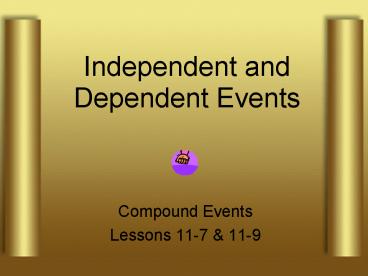Independent and Dependent Events PowerPoint PPT Presentation
1 / 22
Title: Independent and Dependent Events
1
Independent and Dependent Events
- Compound Events
- Lessons 11-7 11-9
2
Independent Events
- Whatever happens in one event has absolutely
nothing to do with what will happen next because - The two events are unrelated
- OR
- You repeat an event with an item whose numbers
will not change (eg. spinners or dice) - OR
- You repeat the same activity, but you REPLACE the
item that was removed.
3
Independent Events 1
- The two events are unrelated
- P(choosing a jack, rolling a 2)
- P (spinning a 3, pulling an ace)
- P (rolling a 6, spinning a red)
4
Independent Events 2
- You repeat an event with an item whose numbers
will not change (e.g. spinners, dice, flipping a
coin, etc.)
5
Independent Events 3
- You repeat the same activity by pulling something
out, but you REPLACE the item that was removed.
6
Dependent Event
- What happens during the second event depends upon
what happened before. - In other words, the result of the second event
will change because of what happened first.
7
Dependent Event
- Look for the following 2 clues to determine if an
event is dependent - You repeat the same event
- You remove something after the first event and DO
NOT REPLACE it. - You ask yourself the question, What happens
second? and your answer is It depends...
8
Representing and Solving for a Compound Event
- Two events are listed and there is a comma in
between them. - P(yellow, yellow)
- P(heads, tails)
- P(6, even number)
- P(not 6, not 5)
- Events must occur in the order listed.
- Figure out the probability of the first event and
multiply it by the probability of the second
event. - Remember that the probability of a second event
changes in dependent events. - It does not change with an independent event.
9
Solving Independent Events
- When you have two independent events
- Find the probability of the first event
- Find the probability of the second event
- Multiply the probabilities together
- Reduce your answer
- Remember that the two events have nothing to do
with one another because they involve 2 separate
items OR one item, but things are replaced after
the first draw.
10
An Independent Event
- There are 10 socks in a basket 5 blue, 3 yellow
and 2 red. What is the probability of choosing a
yellow sock and a red sock if the sock is
replaced after the first event?
is replaced
P(yellow, red) Yellow Replace the yellow
sock. Red
x
11
Solving Dependent Events
- When you have two dependent events
- Find the probability of the first event
- Figure out what has changed
- Numerator and/or denominator
- Figure out the probability of the second event
- Multiply the 2 probabilities together
- Reduce your answer
- Remember that the two events are interconnected.
- Items are NOT replaced after being pulled out.
12
A Dependent Event
- There are 10 socks in a basket 5 blue, 3 yellow
and 2 red. What is the probability of choosing a
yellow sock and a red sock if the sock is NOT
replaced after the first event?
is NOT replaced
P(yellow, red) Yellow DO NOT replace the
yellow sock. Red
Notice that the denominator changed
x
13
TEST YOURSELF
- Are these dependent or independent events?
14
Are these dependent or independent events?
- Tossing two dice and getting a 6 on both of them.
Independent Event
15
Are these dependent or independent events?
- You pick the letter Q from a bag containing all
the letters of the alphabet. You do not put the Q
back in the bag before you pick another tile.
Dependent Event
16
Are these dependent or independent events?
- You have a bag of marbles 3 blue, 5 white, and
12 red. You choose one marble out of the bag,
look at it then put it back. Then you choose
another marble.
Independent Event
17
Are these dependent or independent events?
- You pick the letter W from a bag containing all
the letters of the alphabet. You put the W back
in the bag and pick a second time.
Independent Event
18
Are these dependent or independent events?
- You have a basket of socks. You need to find the
probability of pulling out a black sock and its
matching black sock without putting the first
sock back.
Dependent Event
19
Find the probability
x
- P(jack, green)
20
Find the probability
x
- P(6, not 5)
21
Find the probability
x
- P(Q, Q)
- All the letters of the alphabet are in the bag 1
time - Do not replace the letter
0
22
Find the probability
The num. changed to a 4 because you pulled out a
striped marble. Now the bag is missing one.
- P(striped, striped)
- There are 10 marbles in the bag
- 5 striped
- 5 solid
- Do not put the first marble back.
x
The denominator changed to a 9 because we have
one less marble in the bag since we did not put
it back!

